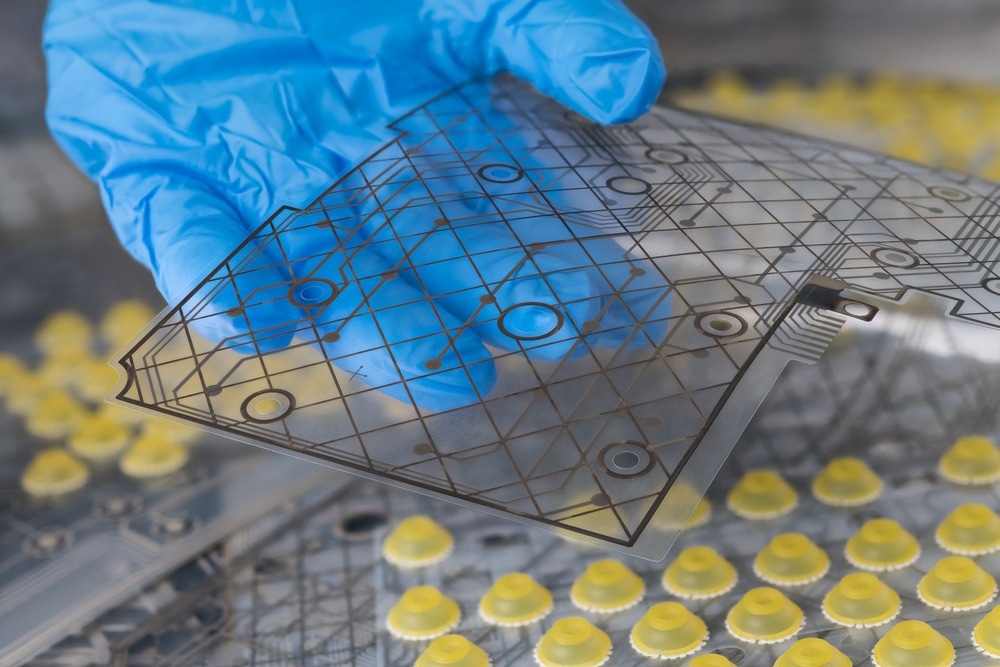The production of nitrogen oxide (NiO) enriched copper oxide (CuO) nanoflakes from discarded flexible printed circuit boards (FPCBs) utilizing micro recycling methods is the subject of a recent paper published in the journal Scientific Reports.

Study: Value-added fabrication of NiO-doped CuO nanoflakes from waste flexible printed circuit board for advanced photocatalytic application. Image Credit: KPixMining/shutterstock.com
Electronic garbage (e-waste) disposal triggers a variety of environmental issues. However, exploiting this hazardous waste as a reservoir of valuable metals could be possible. These metals can be salvaged and altered for use in constructive applications, such as the creation of nanoparticles for hydrogen production through thermodynamic electrolysis of water.
Flexible Printed Circuit Boards (FPCBs): An Important E-Waste
As organic resources deplete, the industrial sector must adopt creative techniques to replace traditional resources with waste-derived materials. Electronic waste (e-waste), which contains numerous precious metals and non-metals, is one of the most troublesome waste sources.
Flexible printed circuit boards (FPCBs) are composed of more than 99 percent pure copper integrated with non-metals like polyamide and resins. To prevent FPCBs from oxidation, a nickel-based solution is often utilized as a surface finish, especially at soldering sites.
FPCBs are manufactured in huge sheets. They are punched and chopped to the proper size and shape during the final manufacturing phase, leaving behind a huge quantity of waste rich in precious copper (Cu) metal. This Cu could be retrieved using a thermal disengagement method and employed in key industrial applications, including the manufacturing of CuO nanoflakes.
Applications of CuO Nanoflakes
CuO and Cu2O are semiconducting transitional metallic oxides of copper oxide. Cu2O has a direct bandgap of 2.1 eV and is used to create superconductors, photovoltaic cells, and detectors.
CuO, on the other side, is preferred for photoelectrochemical (PEC) purposes because of its excellent physical durability and outstanding light absorption capabilities. CuO nanoflakes are applicable to water-splitting photo electrocatalytic reactions, biosensors, superconductors, photovoltaics, photocatalytic degradation, batteries, and photodiodes.
CuO bandgaps can be tuned from 1.2 to 1.7 eV. The semiconductor can absorb the solar spectrum across a larger spectrum of frequencies, making it an appealing candidate for photovoltaic devices.
However, producing CuO nanoflakes is a very costly operation. As a result, appropriate methodologies for manufacturing CuO nanoflakes from waste products such as e-waste are urgently required.
Production of CuO Nanoflakes from PCB-based Waste Products
In this study, the researchers used a micro recycling technique including a coupled chemical approach accompanied by a streamlined thermal route to create NiO-doped CuO nanoflakes from discarded FPCBs. The researchers also assessed the CuO nanoflakes' potential as light-absorbing nanomaterials for power generation applications.
Inductively coupled, plasma-based optical emission spectrometry (ICP-OES) was used to determine the elemental structure of the CuO nanoflakes. X-Ray photoelectron spectrometry (XPS) examination validated the composition of the CuO nanoflakes.
The phase resolution and crystalline nature of the CuO nanoflakes were investigated using X-Ray diffraction (XRD). A field emission scanning electron microscope (FE-SEM) was used to characterize the microstructures of the produced NiO-doped CuO nanoflakes.
Significant Findings of the Research
In this work, the thermal decomposition and modification of waste FPCBs resulted in the effective synthesis of pure-phase CuO nanoflakes. CuO nanoflakes were created by doping FPCB e-waste with NiO. The existence of the Ni emulsification on the surface of the FPCB to shield it from high temperature resulted in in-situ NiO doping.
The energy change from one state to another in as-prepared CuO nanoflakes is due to quantum isolation in the nanocrystal framework. The theoretical bandgap for a perfect water splitting material is claimed to be 2 eV. However, this range fluctuates from 1.23 to 3 eV in practice.
For water splitting purposes, the real bandgap of bulk CuO (1.2 eV) is deemed low, whereas the bandgap of NiO (3.8 eV) is regarded as high. However, the CuO nanoflakes generated in this work have a visual and infrared reflectivity of 70-75 percent and a bandgap of less than 1.57 eV, making them an excellent contender for energy harvesting applications.
These discoveries are expected to stimulate future study into the use of materials produced from hazardous e-waste to synthesize high-value nanomaterials with high economic potential.
Reference
Hossain, R. et al. (2022). Value-added fabrication of NiO-doped CuO nanoflakes from waste flexible printed circuit board for advanced photocatalytic application. Scientific Reports. Available at: https://www.nature.com/articles/s41598-022-16614-4
Disclaimer: The views expressed here are those of the author expressed in their private capacity and do not necessarily represent the views of AZoM.com Limited T/A AZoNetwork the owner and operator of this website. This disclaimer forms part of the Terms and conditions of use of this website.